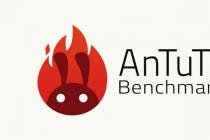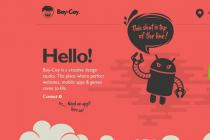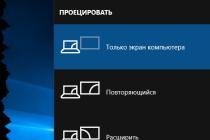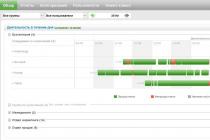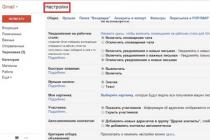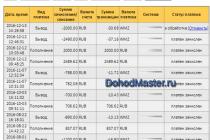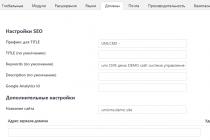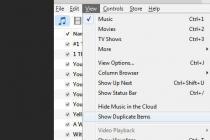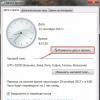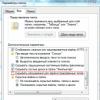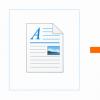Currently, the following forms of IP in enterprise management are common:
Individual use of computers;
Automated workplaces (AWP);
Local area networks (LAN).
As part of the AWP software, two main types of software can be distinguished, differing in functions: general (system) and special (applied).
TO common software refers to a set of programs that automates the development of programs and the organization of an economical computing process on a PC, regardless of the tasks being solved.
Special (application) software is a collection of programs for solving specific user problems.
The main purpose of general software is to launch application programs and control the process of their execution.
Special software AWP usually consists of unique programs and functional packages of applied programs. The specific specialization of the automated workplace depends on the functional packages.
The main applications of the software packages that are part of the special AWS software are word processing, tabular data processing, database management, machine and business graphics, human-machine dialogue, communication support and networking.
Taking into account the modern functional structure of territorial management bodies, the set of software and hardware should form at least a three-level global data processing system with a developed set of peripheral facilities at each level (Fig. 4.2).
First level - central computing system of a territorial or corporate body, including one or more powerful computers, or mainframes. Its main function is general, economic and financial control, information services for management workers.
Second level computing systems of enterprises (associations), organizations and firms, which include mainframes, powerful PCs, provide data processing and control within the structural unit.
Rice. 4.2. Schematic diagram multilevel organization of software and hardware IS
Third level - locally distributed computer networks based on PCs serving the production areas of the lower level. Each site is equipped with its own PC, which provides a set of works on primary accounting, accounting for needs and resource allocation. In principle, it can be automated workplace(AWP) performing functional computational procedures within a certain subject area.
Problem-based RFP - the most functionally developed and numerous RFPs. These include the following software products:
Publishing systems,
Actual editors,
Demo graphics,
Multimedia systems,
CAD software,
Organizers of work,
· spreadsheets(table processors),
Database management systems,
Character recognition programs,
· Financial and analytical and statistical programs.
Spreadsheets (spreadsheet processors) software packages for processing tabularly organized data. The user can use the tools of the package to carry out various calculations, build graphs, control the format of input-output data, compose data, conduct analytical studies, etc.
Currently, the most popular and effective packages of this class are Excel, Improv, Quattro Pro, 1-2-3.
Work organizers - These are software packages designed to automate the planning procedures for the use of various resources (time, money, materials) both for an individual and for the entire company or its structural divisions.
To packages of this type include: Time Line, MS Project, SuperProject, Lotus Organizer, ACTI.
Rice. 4.3. RFP classification
Word processors- programs for working with documents (texts), allowing you to compose, format, edit texts when the user creates a document. Recognized leaders in the field of word processors for PCs are MS Word, WordPerfect, Ami Pro.
Desktop publishing systems (NIS) - software for professional publishing activities that enable electronic layout of basic types of documents, such as newsletter, short color brochure and voluminous catalog or trade request, directory.
The best packages in this area are Corel Ventura, PageMaker, QuarkXPress, FrameMaker, Microsoft Publisher, PagePlus. Apart from the first one, the rest of the packages are created in accordance with the Windows standards.
Graphic editor - processing packages graphic information; are divided into RFP processing of raster graphics and images and vector graphics.
SPP of the first type are designed to work with photographs. The packages provide the ability to convert photos into images with a different degree of resolution or other data formats (such as BMP, GIF, etc.). Recognized leader among packages of this class Adobe photoshop... Notable packages are Aldus Photostyler, Picture Publisher, PhotoWorks Plus. All programs are designed to work in the Windows environment.
Demo graphics packages are constructors of graphic images of business information, that is, a kind of video show designed to present the results of some analytical research in a visual and dynamic form. The most popular packages of this type include PowerPoint, Harvard Graphics, WordPerfect Presentations, Freelance Graphics.
Design automation systems. They are intended for the automation of design and construction work in mechanical engineering, automotive, industrial construction, etc.
A kind of standard among the programs of this class is the AutoCAD package from Autodesk. Note also the programs and DesignCAD, Drafic CAD Professional, Drawbase, Microstation, Ultimate CAD Base and Turbo CAD. These packages are rich functionality and are designed to operate under Windows (Windows NT) or OS / 2.
Group financial programs ... With the help of programs Quicken, DacEasy Accounting, Peachtree for Windows, you can automate accounting. The same function is performed by a number of domestic programs: "Turbo-accountant". "1C: Accounting", "Accountant" of the firm "Atlant - Inform", etc.
For analytical research, well-proven foreign statistical packages are used, such as StatGraphics, Project-Expert, or the domestic development of Statistic-Consultant.
Integrated software packages - in terms of the number of product names, it is not numerous, but computationally powerful and actively developing part of the software.
Typical and most powerful packages of this type: Borland Office for Windows, Lotus, SmartSute for Windows, Microsoft Office... The professional edition of these packages contains four applications: a text editor, a DBMS, a spreadsheet processor, and demo graphics programs.
A feature of the new type of package integration is the use of shared resources. There are four main types of resource sharing here.
1. Using the utilities common to all programs in the complex. For example, the spell checker is available from all programs in the package.
2. The use of objects that may be in sharing several programs.
3. Implementation of a simple method of transition (or launch) from one application to another.
4. Implementation of automation tools for working with an application (macro language), built on the same principles, which allows organizing complex information processing when minimum costs for programming and teaching programming in the language of macros.
The mechanism of dynamic layout of objects allows the user to place information generated by one application into a document generated by another. The user can edit information in a new document by means of the product with which this object was created (when editing, the corresponding application is automatically launched). Running application and the document-container processing program displays the hybrid menu for the convenience of the specialist. In addition, this mechanism allows you to transfer OLE objects from the window of one application program to the window of another.
This technology also provides for the possibility of general use of the functional resources of programs: for example, the graphing modules of a spreadsheet processor can be used in a text editor. The disadvantage of this technology is the limitation of the graph format to one page size.
Open Doc is an object-oriented system based on the open standards of the firms involved in the development. The object model is the Distributed System Object Model (DSOM) developed by IBM for OS / 2. Compatibility assumed between OLE and OpenDoc.
ARM METEOROLOGIST
Operator's manual
Saint Petersburg
List of figures ................................................ .................................................. .......................... 4
List of tables ................................................ .................................................. .............................. 5
Annotation................................................. .................................................. ................................... 6
Symbols and abbreviations ............................................... .................................................. ....... 7
1. Purpose ............................................... .................................................. ........................... eight
1.1 Main functions ............................................... .................................................. ...... eight
1.2 Main parts user interface...................................................... 8
1.3 Access levels ............................................... .................................................. ............. eight
2. Working with the application ............................................. .................................................. ........ 10
2.1 Startup ................................................ .................................................. .......................... 10
2.2 Real time block .............................................. .............................................. 10
2.3 Items of the main menu: ............................................. ................................................. 12
3. Data entry .............................................. .................................................. ........................ thirteen
3.1 Telegram KN-01 ............................................. .................................................. ........ thirteen
3.1.1 Initialization of input: ............................................ ............................................... thirteen
3.1.2 User interface ............................................. ........................................... thirteen
3.1.3 Control elements ............................................. ............................................... 14
3.1.4 Display elements ............................................. ............................................ 14
3.1.5 Input data ............................................. .................................................. ... 15
3.1.6 Examples of entering visually observed information ................................... 18
3.2 Telegram KN-24 ............................................. .................................................. ........ 23
3.2.1 Snow shooting, purpose and composition .......................................... ............................ 23
3.2.2 User interface ............................................. ........................................... 24
3.2.3 Operating procedure ............................................. .................................................. ........ 25
3.2.4 Entering route data ............................................ .............................................. 27
3.2.5 Control elements ............................................. ............................................... 27
3.2.6 Test .............................................. .................................................. ............................ 28
3.3 Telegram KN-19 ............................................. .................................................. ........ 29
3.3.1 User interface ............................................. ........................................... 29
3.3.2 Testing the Climate and Decade telegrams .......................................... ............... 29
3.3.3 Entering norms ............................................. .................................................. ................. 31
3.4 WAREP telegram ............................................... .................................................. .... 33
3.4.1 Formation of the WAREP telegram ............................................ ......................... 33
3.4.2 OL criteria ............................................. .................................................. ............. 35
3.5 Formation of a mode message (block code) .......................................... 36
3.5.1 User interface ............................................. ........................................... 36
3.5.2 Regime software and PERSONA-MIS software. Directories ................................................. ..... 37
3.5.3 Configuring the PERSONA-MIS software for AMK data processing ........................... 38
3.5.4 Entering passport data using the UPH module ........................................ ........ 40
4 Additional information ............................................... ............................................ 41
4.1 Service information ............................................... ............................................. 41
4.2 Searching for messages in the archive ............................................. ........................................... 42
5 Entering corrections ............................................... .................................................. ..................... 44
6 Reports ................................................ .................................................. ................................ 45
List of Figures
Rice. 1 Main window of the Meteorologist's workstation ............................................. ....................................... eleven
Rice. 2 Input of non-automated data for KN-01 .......................................... .............. 14
Rice. 3 Precipitation input form .............................................. .................................................. ..... sixteen
Rice. 4 Window for entering cloudiness forms, page "Lower tier" ....................................... ... eighteen
Rice. 5 Entering information from cloudiness in the absence of clouds ........................................ 19
Rice. 6 An example of entered visually observable information ..................................... 20
Rice. 7 Selecting the cloud shape .............................................. ................................................ 21
Rice. 8 Example of lower clouds input ............................................. ........................................ 22
Rice. 9 Example of lower clouds input ............................................. ........................................ 23
Rice. 10 Entering information about snow shooting, window "Snow shooting" ........................................ .24
Rice. 11 Form for entering a snow survey route ............................................. ............................ 25
Rice. 12 Formation of DECAD and CLIMATE telegrams ............................................ ............. 29
Rice. 13 Formed telegram CLIMATE .............................................. ....................... thirty
Rice. 14 Monthly withdrawal table .............................................. .......................................... 31
Rice. 15 Form of entry of norms .............................................. .................................................. ........ 32
Rice. 16 Exceeding the threshold .............................................. ............................... 33
Rice. 17 Formation and transmission of the WAREP telegram ............................................ ............. 34
Rice. 18 Criteria for hazardous events .............................................. ........................................... 35
Rice. 19 Form for creating the formation of mode information with an example of the generated block code ....................................... .................................................. .................................................. .... 36
Rice. 20 Setting the station passport .............................................. .......................................... 37
Rice. 21 File Akrits. mis ................................................. .................................................. ............ 38
Rice. 22 UPH module ............................................... .................................................. ................... 39
Rice. 23 Service information and synchronization of AWP and controller ........................... 40
Rice. 24 Search for messages in the archive of telegrams and messages .......................................... .... 41
Rice. 25 Entering correction factors into the controller ............................................ .42
Rice. 26 Reports ................................................ .................................................. .......................... 43
List of tables
Table 1. An example of a valid sequence of periods for a 2 time zone: .... 14
annotation
The Operator's Manual, Part 1, contains a description of the system and determines the procedure for the operator (observer) to act when working with the special software of the METEOROLOGU ARM. Software version: 1.4.6
Abbreviations and abbreviations
AMK - Automatic meteorological complex,
VNGO - the height of the lower boundary of the clouds,
KN-01 - code form for coding synoptic information,
KN-19 - code form for coding climate information,
KN-24 - code form for coding snow survey data,
MDV - meteorological visibility range,
OS - operating system,
ОЯ - dangerous phenomena,
Software - software,
PC - personal computer,
STORM - code for encoding storm information,
UTC - Coordinated Universal Time,
WAREP is a code form for coding information about OY.
1. Purpose
1.1 Main functions
The software is intended for use as part of AMK hardware and software systems
The main tasks of the software: automation of the process of registration and distribution of measurement data.
Functional purpose of the software:
Interaction with the QML201 controller using an agreed exchange protocol;
Display of data on-line observations;
Synchronization of station time with PC;
Synchronization of station settings with software;
Providing a means of entering visually observable parameters;
Display of telegrams generated by the station;
Archiving of sent messages;
Keeping an archive of every minute observations;
Keeping a protocol of work;
Visualization of archived data.
1.2 Main parts of the user interface
The monitoring unit, in real time, for the automatically measured parameters - the main window of the application. The main window of the application displays data on-line observations.
To enter data, select a channel, fill in the table on the right (New amendments) and click the Set button.

Rice. 25 Entering correction factors into the controller.
To enter data, fill in the table on the right and click the "Set" button.
To view the entered corrections - either "Read" or view the data in the service connection mode.
View> Reports menu item.
The reports module allows you to generate and print a number of reports on monthly data (files DATA \ YYYYMM_Msg. Cds, where YYYY is the year, MM is the month). By default, the file for the current month is loaded. By clicking the Load button, you can load another source data file.

Rice. 26 Reports
Data export to MS Excel is possible. After export, a message appears indicating the location and name of the file with the xls extension:

The module allows you to generate four types of reports:
· Reports on terms;
· Simple report (contains hourly data);
· Report by day;
· Report on decades.
Generation of reports for days and decades is available after the first report is generated.
As part of the AWP software, two main types of software can be distinguished, differing in functions: general (system) and special (applied). The general software includes a set of programs that automates the development of programs and the organization of the economic, computing process on a PC, regardless of the tasks being solved. Special (application) software is a collection of programs for solving specific user problems.
Taking into account the modern functional structure of territorial government bodies, the set of software and hardware should form at least a three-level global data processing system with a developed set of peripheral facilities at each level.
The first level is the central computing system of a territorial or corporate body, which includes one or more powerful computers, or mainframes. Its main function is general, economic and financial control, information services for management employees.
The second level is the computing systems of enterprises (associations), organizations and firms, which include mainframes, powerful PCs, provide data processing and management within a structural unit.
The third level - locally distributed computer networks based on PCs, serving the production areas of the lower level. Each site is equipped with its own PC, which provides a set of works on primary accounting, accounting for needs and resource allocation. In principle, it can be an automated workstation (AWS) that performs functional computational procedures within a certain subject area.
Problem-oriented PPPs are the most functionally developed and numerous PPPs. They include the following software products: word processors, publishing systems, graphic editors, demo graphics, multimedia systems, CAD software, work organizers. And also, spreadsheets (spreadsheet processors), database management systems, character recognition programs, financial and analytical and statistical programs.
Spreadsheets (tabular processors) are software packages for processing tabularly organized data. The user can use the tools of the package to carry out various calculations, build graphs, control the format of data input-output, compose data, conduct analytical studies, etc.
Work organizers are software packages designed to automate the planning procedures for the use of various resources (time, money, materials) both for an individual and for the entire company or its structural divisions.
Word processors are programs for working with documents (texts) that allow you to compose, format, edit texts when a user creates a document.
Desktop publishing systems (NIS) are programs for professional publishing activities that allow electronic layout of the main types of documents, for example, a newsletter, a short color brochure and a voluminous catalog or trade application, a reference book.
Graphic editors - packages for processing graphic information; are divided into RFP processing of raster graphics and images and vector graphics. SPP of the first type are designed to work with photographs. The packages provide the ability to convert photos to images with a different degree of resolution or other data formats. Packages with vector graphics are intended for professional work related to artistic and technical illustration, followed by color printing. They have a wide range of functionalities for complex and accurate processing of graphic images.
Integrated software packages - in terms of the number of product names, they are not numerous, but computationally powerful and actively developing part of the software. Traditional, or fully connected, integrated software systems are a multifunctional stand-alone package in which the functions and capabilities of various specialized (problem-oriented) packages, related in the sense of data processing technology at a separate workplace, are combined into one whole.
Country support:
Operating system: Windows
Family: Universal Accounting System
Purpose: Business automation
AWP program
The main features of the program:
The program can be translated into any language convenient for you. In addition, you can work with several languages at once.
You can keep an electronic medical history in the program
The program includes academic knowledge with a categorized list of ICD diagnoses
For various diagnoses according to ICD, a plan for the required examination and treatment has already been drawn up
All test results can also be stored in the program
Setting up the filling of templates for research will help optimize the work of all your specialists and get rid of paper documentation
You can attach pictures and any files to the patient's history
Any letterhead in MS Word format can be set as a template for filling
To prevent patients from waiting in line for an appointment, you can use an appointment
It is possible to use discount cards
Supports automatic and manual write-off of medicines and materials for research. Pharmacy sales
For all services, you can set up a calculation, and then consumables will be written off automatically
Modern system to work with patients will help employees to complete all important tasks on time
You will be able to observe how your client base is growing rapidly and attract new patients using the modern capabilities of the program
You will find out on which days of the week or day of the month you have the most patients, this will make it easy to manage the workload of each department
The system will show which of the patients brought you the most profit, and you can easily reward such clients with a personal price list or bonuses
The report will show which of the patients did not fully pay for their purchases or which of the suppliers you have not yet fully settled with
Each of your marketing decisions will be taken into account and analyzed according to the number of new patients and payments
Managers will be able to easily find out which of your clients has not appeared for a long time and immediately contact them
Reason for leaving statistics can help you avoid patient outflow
Your specialists can be easily compared according to various criteria: number of patients, services provided, profit and productivity
You will find out which doctors often come back to patients, and who can lose your clients
Piecework wages of specialists are easily calculated automatically, taking into account personal rates
For each doctor or department, you can find out the dynamics of the growth of visits and services for any period
A special report will show the most profitable or popular services
You can find out all statistics on patients, services and specialists for any convenient period of time and evaluate the dynamics using visual reports
You will receive full statistics on the goods sold or spent on services
For each medication or product, the program will tell you how long its stock will last, which will optimize procurement and storage
The purchasing power report will show the financial capabilities of your customers depending on each branch
All financial movements will be under your complete control. You can easily track what you spend the most money on for any period
Analysis of payments by the values you need will help you make a decision to increase or decrease prices for services and goods
Integration with the latest technology will allow you to shock customers and deservedly gain the reputation of the most modern company
Payment
terminals
Reserve
copying
Appendix
for staff
Appendix
for clients
You can quickly enter the initial data required for the program to work. For this, a convenient manual input or import of data is used.
The interface of the program is so easy that even a child can quickly figure it out
Language of the basic version of the program: РУССКИЙ
You can also order the international version of the program, in which you can enter information in ANY LANGUAGE of the world. You can even easily translate the interface yourself, since all the names will be placed in a separate text file.

The AWP program is an information and technical complex that collects, stores and processes data and automates the management and control of various business processes. The automated workstation of a workstation specialist reduces the possibility of errors or deliberate falsification of data. The program provides management with proper control over the actions of personnel.
The administrator's workstation program visually displays entries for specialists, foremen or in certain offices, provides management of the client base and control of accounting for debts and prepayments. The use of the physician's workstation software ensures the automation of the appointment of the examination and treatment plan according to the diagnosis selected from the base, provides the formation of all the necessary forms and protocols according to the specified templates. The workstation program of the polyclinic stores information on anamnesis and treatment protocols, there are built-in reference books with academic data. The AWP polyclinic program and the AWP inpatient program guarantee the registration of test results, the inclusion and binding of X-ray images, dental records and others to patients electronic documents and scans.
In the AWP program, clients and all contact information on them will never be lost due to a single database of counterparties. On it, you can perform a contextual search with management of various filters and control of grouping and sorting according to certain criteria. The entire history of transactions and relationships will be stored in one place in the program. You can link documents or any electronic files to the records in the administrator's workstation. Work planning is also carried out on the counterparty. Thanks to the program, managers will receive a prompt reminder of the need to make an important call, send a letter or prepare documentation, or hold a meeting. There is automation of mass and individual mailing.
Workstation personnel program allows you to assign an individual work schedule for each employee, provides automation of the calculation of fixed and piecework wages, allows you to keep track of the employee's performance. The AWS store program will lead to the automation of the cashier, storekeeper: it maintains and keeps records of all types of payments, inventory, accounting of balances in warehouses, the formation of invoices, receipts and orders.
You will not need instructions on how to install the AWP program: our specialists work with all near and far abroad for remote installation. Software AWP works on local network and the internet. There is management remote access and blocking control in case the user leaves the workplace.
In the AWP program, users are protected by a password, in addition to each account you can delegate your access rights. Ordinary employees receive management of only information necessary for their work, for example, accounting. The management is provided with all the necessary control of any edits and changes, all reporting and its visualization for analyzing the management of a company or enterprise.
On the website of the Universal Accounting System, you will find many ready-made types of AWP programs and you can practically familiarize yourself with their capabilities by downloading the demo versions of the program. After the decision, our specialists will delve into all the subtleties of doing your business and will offer the most complete complex for automating management and control. We are waiting for your calls!
The program can be used by:
Anatoly Wasserman presents a new version 5.0 of the USU program
In addition to the opinions of ordinary users about the USU program, the opinions of experts are now presented to your attention. Anatoly Wasserman was born on December 9, 1952. Graduated from the Odessa Technological Institute of the Refrigeration Industry, specializing in engineer. After graduation, he worked as a programmer. Then he became a system programmer. For the first time appeared on the screen in 1989 in the club “What? Where? When? ”, Then - at the“ Brain-ring ”. He won fifteen consecutive victories in 2001-2002 in the television "Svoi Game" and became the best player of the decade in 2004. Five-time champion of Ukraine in the sports version of his own game. Four-time Moscow champion in the sports version of Svoy Igry, bronze medalist of the same competition, silver in 2017. Silver medalist of the "Experts" - World Games of Experts - 2010 in "Your own game".
Executive Management Supplement - The Modern Executive's Bible
Supplement to the program for professional managers: to develop business and increase income. A unique product developed at the intersection of two sciences: economics and information technology. No analogues
With the advancement of technology, life is accelerating. Everywhere you need to be in time - because the faster you do things, the more you earn. For this reason, it is very important to have a feature-rich mobile app on hand.
Alexander Druz about the Universal Accounting System
In addition to the opinions of ordinary users about the USU program, the opinions of experts are now presented to your attention. Alexander Druz is the first master of the "ChGK" intellectual game. He was awarded the Crystal Owl prize for the best player of the club six times. Winner of the "Diamond Owl" prize for the best player. Champion of the television version of the "Brain-ring". In the TV show "Own Game" he won the "Linear Games", "Super Cup", won the "III Challenge Cup" with the team, set an absolute record for performance in one game. Author and presenter of intellectual games and educational programs on various TV channels.
Maxim Potashev on the effectiveness of the USU program
In addition to the opinions of ordinary users about the USU program, the opinions of experts are now presented to your attention. Maxim Potashev - master of the game “What? Where? When? ”, Four-time winner of the“ Crystal Owl ”prize, twice world champion, three times champion of Russia, six-time champion of Moscow, three-time winner of the Moscow Open Championship in the game“ ChGK ”. According to the results of a general audience vote in 2000, he was recognized as the best player in all 25 years of the elite club's existence. 50 thousand viewers of the program voted for the candidacy of Maxim Potashev. Received the "Big Crystal Owl" and the main prize of the jubilee games - the "Diamond Star" of the master of the game. Member of the Board and since 2001 - Vice President of the International Association of Clubs. By profession - mathematician, marketer, business coach. Graduated from the Faculty of Management and Applied Mathematics, taught at the Department of General and Applied Economics at the Moscow Institute of Physics and Technology. In August 2010 he was elected President of the All-Russian public organization "Federation of Sports Bridge of Russia". Leads a consulting company that helps various organizations solve problems related to sales, marketing, customer service and business process optimization.
3.1 General software workstation
General software is a part of the software of an automated system, which is a collection of programs designed for a wide range of users and designed to organize the computing process and solve frequently encountered information processing problems.
Common software includes:
· OS;
· System programs;
· programming languages;
· Tools for creating programs.
Operating systems (it is necessary to indicate the operating system recommended for use in a given workstation).
The most widespread in Russia are the dialog operating systems Windows (95; 98; 2000; 2007, etc.), Windows NT, Windows ME, Windows XP, Windows Vista, etc.
Windows 2000, Windows ME, Windows XP are the simplest operating systems that allow convenient form to interact a person with a computer.
Windows NT is most often used in workplaces in large corporations... It places high demands on computer resources and has built-in capabilities to restrict access to data.
Operating room Windows system Vista is distinguished by increased security and reliability of protection against viruses, design, ease of search and systematization of information, the ability to work with sound, photo and video files. But it places higher demands on the PC.
System programs include:
· Software drivers that expand the OS's capabilities to control input-output devices and multimedia;
Auxiliary programs (utilities): programs for copying, backup, antivirus software, programs for limiting access, programs for archiving (WinRAR), etc.
Programming languages.
Programming languages determine the principles of creating programs and are most often used to write narrowly focused programs on the order of specialists. The most commonly used are BASIC, Pascal, Fortran, C ++, Prolog, Lisp, etc.
Narrow-oriented programs can be efficiently created using Excel and MathCAD tools.
Tools for creating programs.
Programming tools are, as a rule, program editors for the corresponding programming languages, which provide a means of highlighting subroutines or functions and greatly facilitate the debugging of programs. These tools include: Visual Basic, Turbo Pascal, Turbo C, etc.
3.2. Functional software
A functional or application software AWP is a set of interrelated programs designed to implement functions or a group of functions of an automated system and are customizable for a specific application.
Functional software includes:
· Multifunctional packages:
Text editor for publishers;
Graphics editor AutoCAD;
Database management systems;
Computer games;
Electronic directories;
Training programs;
Computer-aided design systems, etc.
· Integrated packages(combine some of the most frequently used programs under a common ideology).
In integrated packages, all the necessary tools are combined within one package, which ensures the compatibility of data recording, the ability to switch to other programs, continuity different types commands and methods of working with the menu. The most popular integrated packages: Microsoft Office, Lotus - 1-2-3, etc.
The integrated Microsoft Office suite includes:
Microsoft Word- a text editor that is effective for typing and editing text, creating formulas (Microsoft Equation 3.0), a set of tables, building charts and trend lines, building elementary diagrams;
Microsoft Excel- spreadsheets that are effective for making calculations in the form of tables, creating formulas for making calculations using mathematical and statistical functions, including sections of probability theory, mathematical statistics, linear programming, differential equations and creating databases;
Microsoft Power Point - used to prepare reports in the form of slides;
Microsoft Access - a database management system (used to store information in the form of tables, perform data analysis);
· Problem-oriented packages.
Problem-oriented packages cover a specific area of knowledge (mathematics, physics, economics, mechanics, etc.). A striking representative of problem-oriented packages is the universal mathematical package MathCAD designed for solving engineering and scientific problems in the amount of higher mathematics.
· Narrow-specific programs are created at the request of specialists by professionals in the subject area of knowledge (dynamics, strength, organization of production, etc.), fluent in programming languages.
Narrow-oriented programs developed by order of AWP users in traditional programming languages or in the Excel and MathCAD environment must be accompanied in accordance with GOST 24.207-80 by the following documents: "program description", "programmer's manual", "operator's manual", "text programs".
As part of the implementation term paper narrowly focused programs are being developed for the following tasks:
- Calculation of the technical and economic criterion of competitiveness;
- Selection of optimal strategies;
- Building statistical models;
- Building models of linear mathematical programming;
- Examination of production
- Development of calculation algorithms and narrowly focused programs as part of an individual assignment.
3.3. List of selected standard software and narrowly oriented programs
Table 3.3. XXXXXXXXXXXXXXXXXXXXXXXXXXXXXXXX
3.4. Methodology for determining the technical and economic criterion of competitiveness of AWP
The numerical values of the technical and economic criterion can be determined by the formula:
where  - an integral indicator of competitiveness in terms of technical parameters;
- an integral indicator of competitiveness in terms of technical parameters;
The number of investigated technical parameters;
 weight coefficient go technical parameter:
weight coefficient go technical parameter:
 the absolute weight of the first technical parameter;
the absolute weight of the first technical parameter;
Empirical coefficient (  .
.
As technical parameters, you can, for example, take the following characteristics system unit and monitor:
![]() clock frequency ();
clock frequency ();
![]() the amount of RAM ();
the amount of RAM ();
![]() mean time to failure ();
mean time to failure ();
![]() volume memory hard disk ();
volume memory hard disk ();
![]() video card memory size ();
video card memory size ();
![]() fan noise ();
fan noise ();
![]() response time (), etc. ( the set of parameters is chosen by the AWP developer);
response time (), etc. ( the set of parameters is chosen by the AWP developer);
 or
or  - a relative indicator of competitiveness, compared parameters of a system unit or monitor ( the first ratio is applied for indicators with an upward trend, and the second - for a decrease: the first five indicators have an upward trend, and the last two - a downward trend). An increase in the relative indicator should correspond to an improvement in product quality (AWP);
- a relative indicator of competitiveness, compared parameters of a system unit or monitor ( the first ratio is applied for indicators with an upward trend, and the second - for a decrease: the first five indicators have an upward trend, and the last two - a downward trend). An increase in the relative indicator should correspond to an improvement in product quality (AWP);
Absolute value th technical parameter for the designed option;


